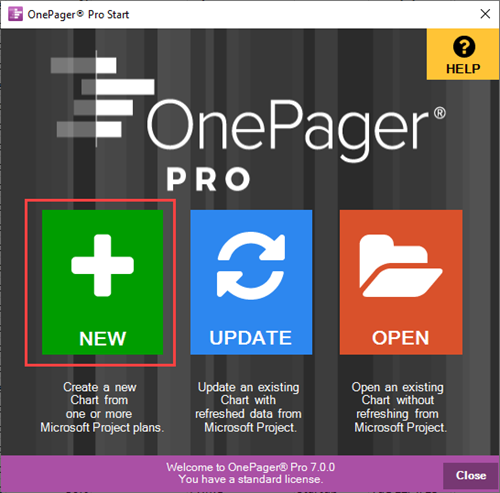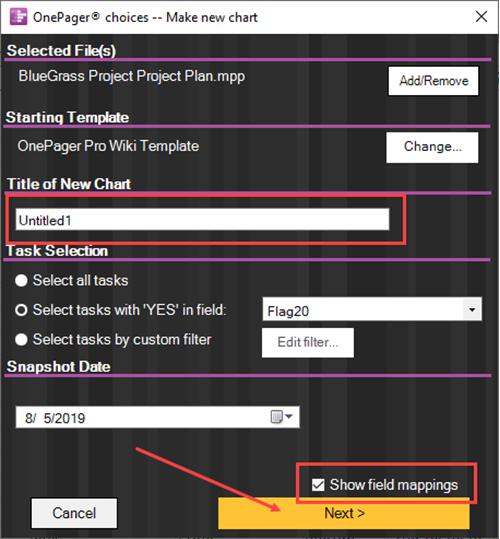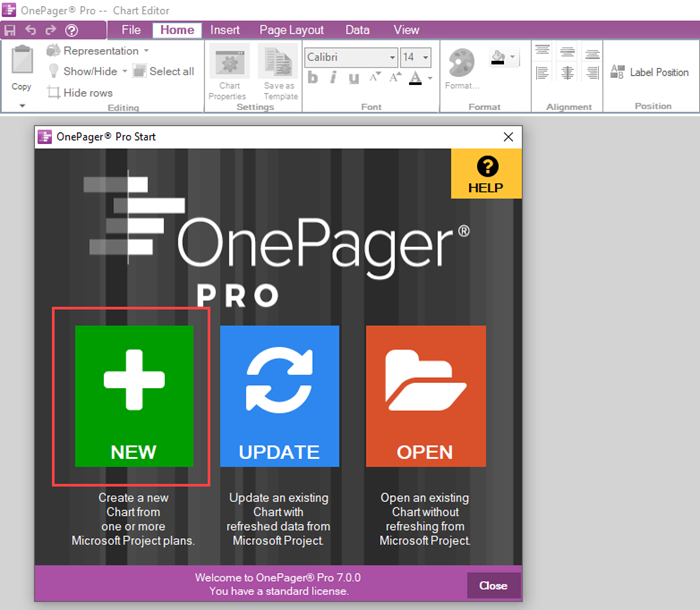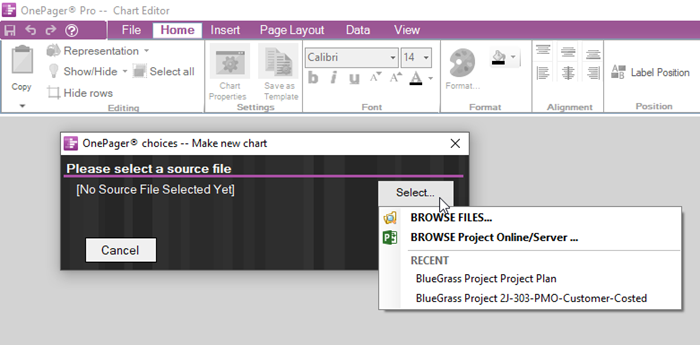Creating Another New Chart using Microsoft Project Data for Version 7.1
Contents
Introduction
Overview
1) Often, there is more than one audience that is interested in seeing a OnePager chart schedule presentation for a project.
2) Each audience may want to see different tasks and milestones in the schedule in a different representation.
3) With OnePager, you can create different charts from the same Microsoft Project source plan and tailor them to different audiences with different schedule conversation needs.
4) This is accomplished by inserting two or more Flag/Number fields into the Microsoft Project source plan’s file then instructing OnePager to produce additional charts using these alternative Flag/Number fields.
5) For example, Flag20 can be used to create the OnePager chart for an executive team, while Flag10 is used as the Flag for internal project team presentations.
6) Further, Flag5 can be reserved to create charts and update for schedule presentations to the customer.
7) By inserting these three Flag fields into the Microsoft Project source plan and appropriately populating the cells with Yes and No, three different charts can be prepared, snapshots can be added to them, and updated or replaced as needed.
8) The steps to accomplish this process are similar to creating a NEW chart, but with slight differences.
Links to Add-in and Standalone Sub-Sections
This article has two major sections below. The first major section is for OnePager Pro Add-in Procedure and the second major section is for OnePager Pro Standalone Procedure. Please use these links to navigate to the appropriate section based on how you are using OnePager.
OnePager Pro Add-in Procedure
1) Launch Microsoft Project and access the desired Microsoft Project source plan.
2) Add any additional Flag/Number fields in the Microsoft Project source plan as required for creating charts for additional audiences.
3) These added Flag/Number fields are used to determine which source plan tasks and milestones to import.
4) Determine which of the tasks and milestones in the source plan are to be included and set the Flag/Number field cell to Yes leaving the remainder of the task's and milestone's flag field set to No.
5) Click the OnePager button from the Microsoft Project ribbon tool bar. OnePager accesses the OnePager Pro Start form. Then click the NEW button:

6) OnePager displays a OnePager choices (OPC) form as shown below:

7) When you create another chart, we suggest that you give the new chart with the alternate Flag a new name that is suggestive of the different audience intended to see the presentation.
8) Each chart or .TAM file has its own unique file name and path name. To avoid confusion it is best to create unique file names for charts from the same Microsoft Project source plan that uses an alternative flag field.
9) Once satisfied with the chart's name and selection of Flag field, click the Create new chart button (if you did not check the Show field mappings checkbox) or the Next> button (if you did check the Show field mappings checkbox) to create the chart.
10) In this example, OnePager imports the data from the Microsoft Project source plan under the control of Flag20.
OnePager Pro Standalone Procedure
Preparing the Microsoft Project Source Plan
1) Use any additional Flag/Number fields in the Microsoft Project source plan.
2) These added Flag/Number fields are used to determine which plan task and milestones to import.
3) Determine which of the tasks and milestones in the source plan are to be included and set the Flag/Number cell to Yes leaving the remainder of the task and milestone Flag field set to No.
Launching OnePager Pro Standalone
4) Launch OnePager from the Standalone Icon.
5) The OnePager splash page appears briefly followed by the OnePager Chart Editor form displaying the OnePager Pro Start form as shown below:

6) At the completion of paragraph 5) when you click the “NEW” button, OnePager displays an abbreviated OnePager choices (OPC) form as shown below:

7) After you've made your source plan selections, OnePager displays an expanded OnePager choices (OPC) form as shown below:

8) When you create another chart, we suggest that you give the new chart with the alternate Flag a new name that is suggestive of the different audience intended to see the presentation.
9) Each chart or .TAM file has its own unique file name and path name so to avoid confusion it is best to create unique file names for charts from the same Microsoft Project source plan that uses an alternative Flag field.
10) Once satisfied with the chart's name and selection of Flag field, click the Create new chart button (if you did not check the Show field mappings checkbox) or the Next> button (if you did check the Show field mappings checkbox) to create the chart.
11) In this example, OnePager imports the data from the Microsoft Project source plan under the control of Flag20.
Related Links
Creating a NEW Chart via Pull Operation - OnePager Pro
Creating a NEW Chart via Pull Operation - OnePager Express
REPLACING a Snapshot via Pull Operation - OnePager Pro
REPLACING a Snapshot via Pull Operation - OnePager Express
ADDING a Snapshot via Pull Operation - OnePager Pro
ADDING a Snapshot via Pull Operation - OnePager Express
Custom Update (Replacing) of a Snapshot via Pull Operation - OnePager Pro
Custom Update (Replacing) of a Snapshot via Pull Operation - OnePager Express
Using the OnePager "Data" Tab's "Selected file(s)" Button
(7.3.1-71, 7.3.2-71)